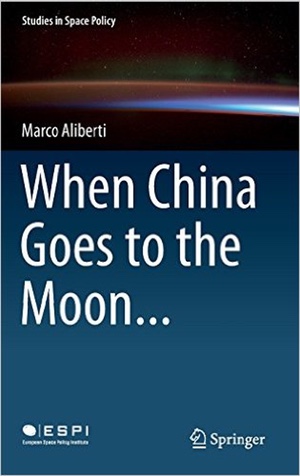Review: When China Goes to the Moon…by Jeff Foust
|
| The book is a good review of what’s known about China’s space program, but also a reminder of how, in many cases, how little is known outside the Chinese government about its plans and intentions. |
If Chinese officials do attend this year’s IAC, they’ll likely be asked questions about the country’s long-term plans for human lunar exploration. That’s the focus of the book When China Goes to the Moon… by Marco Aliberti, a resident fellow at the European Space Policy Institute. The title is a reference of the seeming inevitability of a Chinese human lunar landing—even if the details about how and when it will take place are uncertain—and its implications for international cooperation, particularly with Europe.
The book is a good review of what’s known about China’s space program, but also a reminder of how, in many cases, how little is known outside the Chinese government about its plans and intentions. The early chapters examine the structure of Chinese space efforts and plans for lunar exploration in detail. But some of those basic details, like the annual budget, remain unknown. Aliberti nonetheless offers up an annual budget for China’s space program—$3.5 billion in 2013—based on the average percentage of GDP spent by other nations on their space programs, without any knowledge of whether that percentage is applicable to China. A later chart then breaks down that spending among various projects, like human spaceflight, to the level of hundredths of a percent of the overall budget, a precision unwarranted given the basic uncertainty about overall spending.
It is clear, though, that the Moon is a subject of interest to the Chinese space program, based on its ongoing Chang’e series of robotic lunar missions and public statements about a desire to eventually send humans there. Yet, the book doesn’t shed many new details about any future human lunar exploration plans, including both how China might accomplish those missions and when. Aliberti is skeptical that China will make any mention of it in the next Five-Year Plan, covering the years 2016 to 2020. Instead, it may be deferred to the 2021–2025 or even the 2026–2030 plans, given China’s plans to develop a permanent space station by the early 2020s.
Aliberti examines how China’s eventual human lunar exploration plans might affect cooperation or competition with other spacefaring nations. He is skeptical of claims from several years ago of an Asian space race among China, India, and Japan, citing the lack of progress India and Japan have made in human spaceflight. However, one can argue there is some competition among these nations, and others, today in spaceflight in general: witness the publicity India got for its Mars Orbiter Mission last year, a first for an Asian country (something not discussed by Aliberti.) India and Japan also have robotic lunar lander missions planned for the next several years, and others, including South Korea and Taiwan, have similar missions that are at least at the conceptual stage.
| China has a major opportunity to position itself as a world leader simply by flying people into space, demonstrating it has a capability that, for now, the United States does not. Yet, it has not flown a crewed mission since Shenzhou 10 in June 2013. |
By contrast, he is more bullish on a space race developing between China and the US, especially should China land humans on the Moon. He pitches this as a race between a rising superpower, China, and one in decline with a plateauing economy, the US. The problem with this assessment is that the “threat” of a Chinese human lunar landing has been used in the past to try and win support for NASA’s own plans during the Constellation era a decade ago. Those arguments, though, were not sufficiently persuasive, since they failed to win additional funding for the program, putting it on a path to its cancellation in 2010.
Perhaps the more fundamental issue with this analysis, and the underlying space policy debates about international cooperation and competition, is the perceived importance of human spaceflight to international relations. Much of that debate is colored by the Space Race of the 1960s between the US and USSR, fueled by the Cold War competition between the two nations. But just because human spaceflight was important then—albeit for only about a decade—doesn’t mean it carries similar weight today. Human spaceflight is certainly a highly visible activity, but that doesn’t mean it’s equally influential.
That’s demonstrated by China’s human spaceflight activities today—or, rather, its lack of them. China has a major opportunity to position itself as a world leader simply by flying people into space, demonstrating it has a capability that, for now, the United States does not. Yet, it has not flown a crewed mission since Shenzhou 10 in June 2013, and it’s done only two crewed missions in the last seven years. While China has demonstrated the ability to send people into space, its government has apparently decided that any prestige it would accrue by doing so isn’t worth the resources required—and risk of failures—to fly missions more regularly. Some argue that China is investing in future capabilities, but even so, it’s concluded it’s not worth spending money on both current and future systems.
That doesn’t mean human spaceflight has no benefits at all on the international stage. Aliberti makes the case in the book’s final chapter that Europe could serve as a “bridge-builder,” leveraging its relationships with both the US and China to bring them together in international cooperation that benefits Europe as well. Cooperation, he adds, has the benefit of providing transparency into partners’ plans, something sorely lacking when it comes to China’s space plans. But space cooperation is, at best, only a small part of the solution to improved relations among the world’s leading nations.
